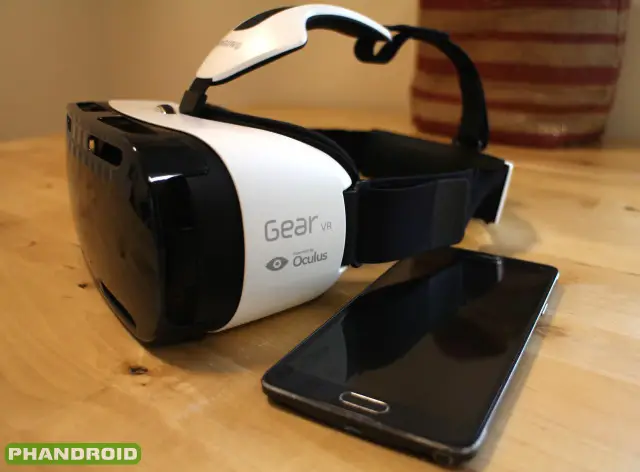
It’s rare that a piece of tech comes along and completely stuns me, but the Gear VR did it.
Samsung’s partnership with Oculus has produced a stunning virtual reality experience with the Gear VR and Galaxy Note 4. The platform still has a long way to go before many casual users will see a need for it, but the early promise has us looking forward to the future of consumer VR technology.
Design & Comfort
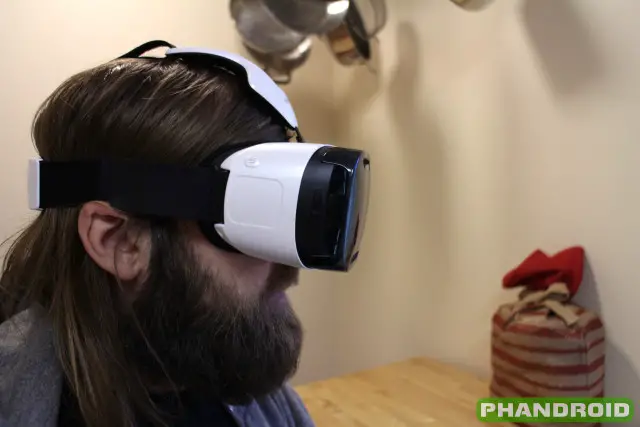
The Samsung Gear VR definitely looks the part, presenting a headset typical of our visions of virtual reality while adding a bit of polish that in its own way implies that the technology has finally arrived for the masses. And that is really what the Gear VR is all about: a consumer-grade virtual reality experience at a (mostly) affordable price.
The Gear VR is built of lightweight plastic that does feel a bit cheap, but that’s a tradeoff we are more than fine with. Keeping the weight of such a headset down is key to wearability. A flimsy plastic shield is removed to reveal the dock for the Note 4. We have found no real purpose for this plastic shield other than that of aesthetics — we left it off and set it aside. The Note 4 plugs into a Micro USB port and locks down with a clamping mechanism. It’s easy to get in and out.

For a pair of futuristic VR goggles, the technology incorporated into the Gear VR is actually quite simple. The headset is mainly utilized for its lenses, which serve to create 3D stereoscopic imagery from content formatted for VR. There is a touchpad for navigation on the side of the goggles as well as volume and back buttons, but the Samsung Galaxy Note 4 and its Oculus tech does the heavy lifting. We have explored the topic in a bit more depth, as well as what it means for folks who want to use the Gear VR with a phone other than the Note 4, in a separate article.
As something intended to be worn on the head for what could amount to significant periods of time, the Gear VR better be designed for comfort. We are happy to say that this is mostly the case with one or two small exceptions.
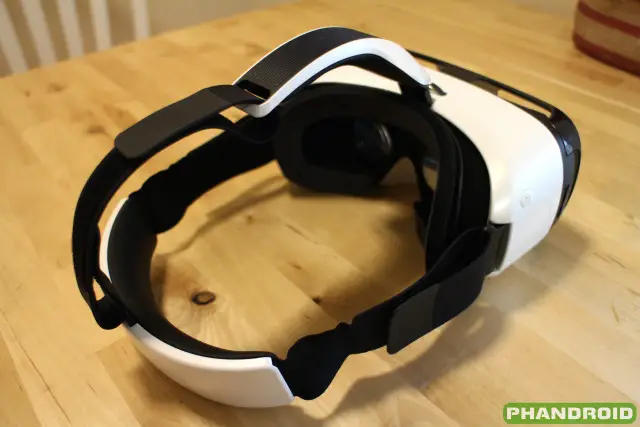
The presence and weight of the Gear VR is noticeable when the Note 4 is docked in the goggles, but not in a way that felt unbalanced or irritating to the head or neck. Give credit here to the headset’s adjustable straps, which offer padded support around the back of the head as well as the top. Around the lens box is a foam gasket that not only protects the skin of the face, but also creates a good seal to block out external light (which goes a long way in selling the VR experience).
Since most of the weight is centered toward the front of the Gear VR, if the straps are not tight enough to pull the goggles snug against the orbits of the eyes it does have a tendency to slip forward and down. If this is the case, the plastic casing has a habit of digging into the top of the nose, which can cause some discomfort over an extended period. It would have been nice if Samsung had included some additional padding in this area, but a bit of foam could easily be added by the user with a bit of strong tape or glue.
VR Experience
Jumping into the virtual world of the Gear VR is simple enough. Insert the Galaxy Note 4 and the Oculus Home app will boot right up. The first time you use the headset you will be treated to a demo featuring a montage of content (some available in a longer format and some exclusive to the demo, for now) that really showcases what the Gear VR can do. For someone with limited experience with VR, it was a mind blowing experience. Sharing the demo with family and friends, it has led to more than a few gasps of amazement.
That one short tech demo is evidence enough that we have something big on our hands with the Gear VR, but the joy of operating extends into some of the more fully fleshed-out apps and videos. Head tracking is nearly flawless with no noticeable latency and smooth operation. You move your head, your POV in the virtual world moves to correspond. As long as the content supports it, you can look about in a full 360 degree range: above, below, to the sides, and behind.
In some cases, games especially, the display can lose calibration causing you to have to turn your head at weird angles to view the content that is intended to be presented as the default view. This is easily enough fixed by holding the back button to access the settings menu and selecting the option to reorient. It’s a minor annoyance that likely has more to do with the way the particular apps or games are programmed than any fault of the Gear VR or its Oculus software.
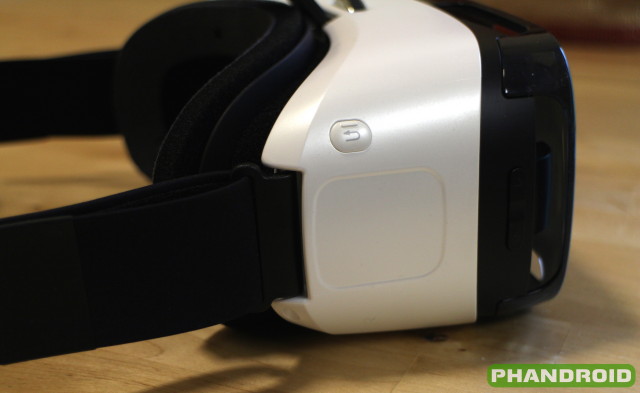
Navigating the interface of the Gear VR is accomplished through a combination of head tracking and a touchpad on the side of the headset. The touchpad can be used to tap selections or swipe through menus. A gamepad can also be connected for navigation purposes (and is required for certain games). As of now there are no hands-free controls for the Gear VR, meaning you will always need at least one physical tap to start up content. It would be nice to see voice commands or gesture support in future iterations.
The VR itself is immersive. We hesitate to say you feel 100% transported to another world, but we found ourselves reaching out into the virtual ether more than once only to realize that our hands and limbs did not exist within the context of the Gear VR. The virtual and 3D effects are executed almost flawlessly.
Whether it was a tour of Iceland, a Cirque du Soleil performance in an empty theater, or a swim through the virtual deep ocean, the experiences were very impressive. We found more interest in 360 video content, but there is definitely some promise on the gaming side as well. A small disappointment is a lack of native support for 180 degree video content.
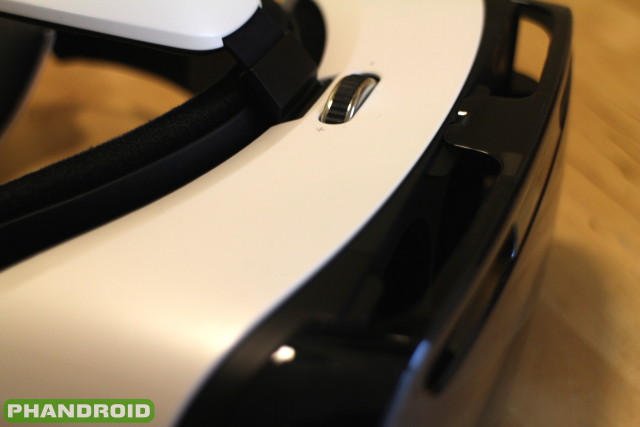
If there is one downside to the viewing experience it is image quality. While the Gear VR features an adjustable focus, it’s hard to get things perfectly free of blur. Full disclosure: I wear glasses for nearsightedness, which cannot be worn with the Gear VR. This may have had an effect on my interpretation of image quality, but others with better vision than I reported similar results.
Even with the Note 4’s high pixel density, the image might have been sharper and most videos lack the rich, vibrant color we have come to expect from Samsung’s Super AMOLED displays. It is again somewhat understandable considering the design. The Gear VR is holding the display only an inch or two away from the eye, so at that distance you are bound to notice visible pixelation. To its credit, the Gear VR does a great job of not simply feeling like you have a smartphone held only an inch or two in front of your eye.
Software
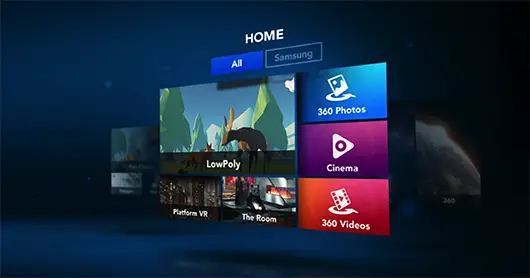
The Gear VR is currently only available in its Innovator Edition, a public beta that launches with limited software support up front. Many of the video and game experiences amount to little more than glorified tech demos, but we found a reason to check out a majority of the content available in the Oculus Store.
The Oculus Home itself is easy enough to navigate, dividing content into categories like 360 Video and 360 Photos, movies, games, and more. Alternatively, accessing the library lays out all content in one place.
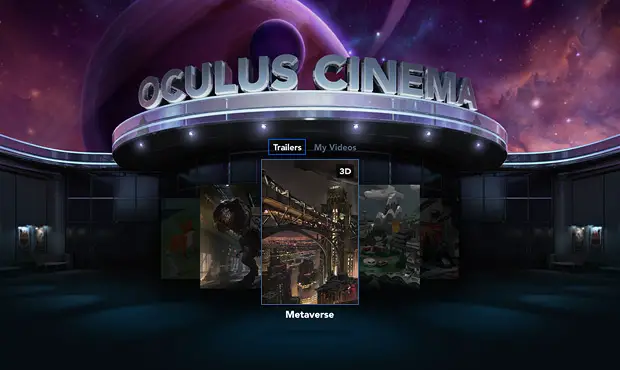
Some of the more specific app experiences include a virtual theater mode for viewing standard 2D and 3D videos not designed for 360 degree head tracking. In this mode you can choose to view in several theater settings, including a home cinema and even the surface of the moon. It is easy to load your own video files for viewing in Oculus Cinema, but streaming services and other media apps cannot be accessed from within the Gear VR interface. As awesome as watching Netflix on the Gear VR sounds, it simply is not possible at this time.
You can also load your own 360 video content for viewing on the Gear VR, and this immersive viewing experience might have been our favorite aspect of the Gear VR. A lot will depend on the quality and production of the video you are viewing, but there is something magical about being able to peer around inside the confines of a virtual world.
Gaming options are currently limited, but what’s here can be addicting. It’s easy to get lost in the role of a hacker playing through a few missions on Darknet. Just be warned, extended use has the potential to cause some headaches or at least mild discomfort or strain.
The bottom line…
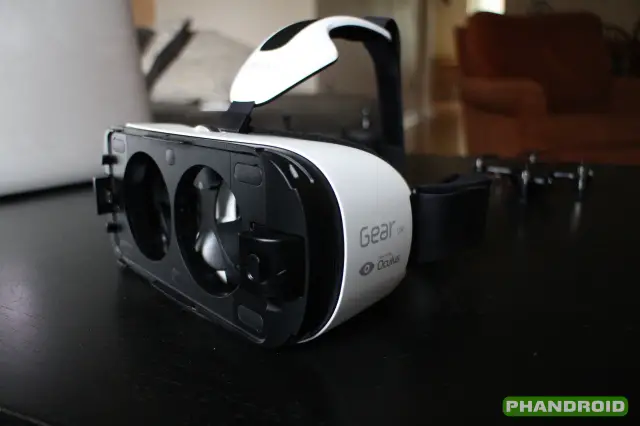
It’s rare that a piece of tech comes along and completely stuns me, but the Gear VR did it. Make no mistake: there is a long way to go before the virtual reality experience presented here is perfect. But the promise of what is possible with the Gear VR (and hopefully more Oculus Mobile headsets to follow) has me excited to see what comes next.
In recent memory, the Gear VR is one of the most fun gadgets I have had the pleasure to play with, but it’s more of a luxury than anything else at this point. For starters, if you don’t have a Note 4 or plans to purchase a Note 4 in the future, the Gear VR is nearly useless. Then there is the fact that this is the Innovator Edition and content support is, as of now, limited. At $200 you aren’t draining the bank, but it wouldn’t be a terrible idea to give the platform a few more months to grow.
Having said that, if you own a Note 4 and want to check out the Gear VR experience, we highly recommend it. It’s hard to imagine you will be disappointed.
The Good
- Immersive virtual reality experience
- Comfortable, lightweight design
- Flawless head tracking and responsive software
The Bad
- Innovator Edition features limited content, no third-party app support
- Only works with Galaxy Note 4
- Can cause headaches or eye strain over prolonged periods of use
Overall: 4.5/5

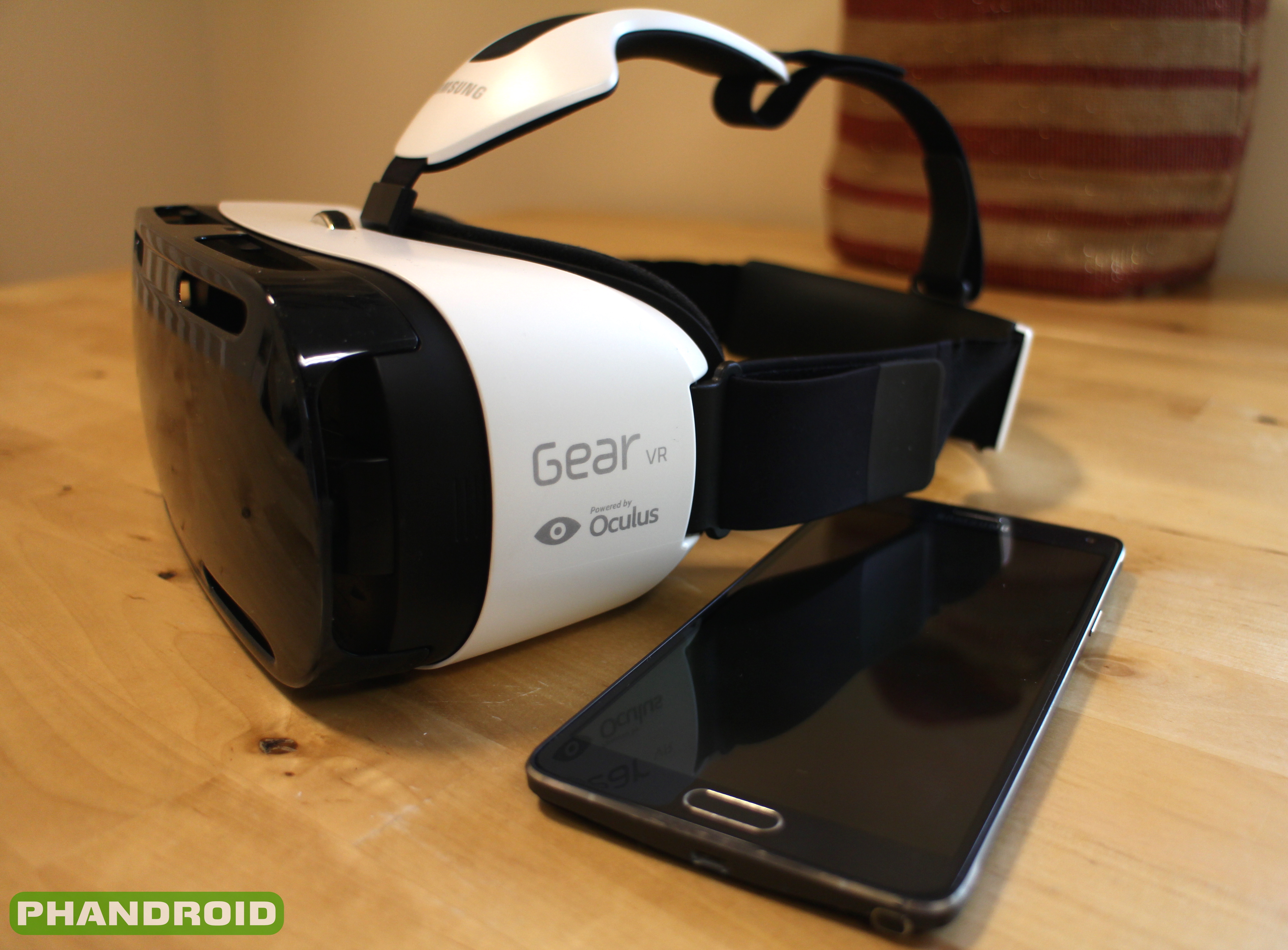



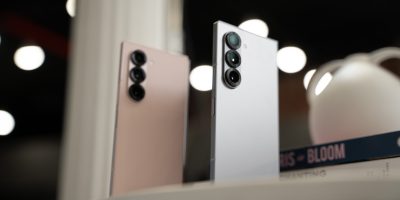




You look like you’re going for a dive there, Kev ;)
How much of the experience relies on stereo vision? Is it of any use for a person with only one eye?
I believe for 3D experience, its essential to have binocular vision.
From the Oculus forums: In a stereovision game, the game is rendered twice, once for each eye. Before rendering, the cameras position is moved a little to the left, and the left view is rendered. Then the cameras position is moved a little to the right, and the right view is rendered. The 2 camera positions are simulating the position of your 2 eyes. The small difference between the 2 camera positions creates the magic.
Both the left, and right images are displayed at the same time in the head mounted display.
Your brain does the rest.
That’s exactly what I’m asking. How much of the experience (UI) is 3D (used to be called stereo). It doesn’t have to be all 3D to provide VR environment. 17 years ago I played Doom in a VR helmet, and it was all 2D.
If you shut one eye it’s still quite convincing, with the amazing head tracking, but it loses the depth.
Thank you, that’s the answer I was looking for!
I expect the porn industry to really make this popular.
Just got mine today from expansys…this is nuts. I took it off 15 mins ago and I’m still reeling.
The pixellation is worse than I expected but the tracking is amazing, it just works. Surprisingly easy to navigate through the menus too. With headphones the audio tracking is excellent too.
Highlights so far are 3D photos from Mars (so.many.stars) and Ocean Rift. Just had 2 dolphins swim up to my nose and got a bit freaked out by a shark. It’s OK though, they put you in a cage. Freaky.
i wonder if the 4K dispaly Note 4 will great improve the graphics/pixelation
I wonder if the 4K dispaly Note 4 will great improve the graphics/pixelation. I did theBlu demo and the space shooter demo and I thought the immersiveness is spot on but the graphics seemed xbox 1 (NO, not Xbox One) ish, not detailed, not realistic and screen door effect (or pixelation if you will) was in full force unfortunately
Yeah – it’s the weak link at the moment. Though AFAIK the Note 4 has the highest PPI of any screen at the moment, 515, so even 4k might not be enough – you might need at least 1000PPI to get that sharpness.
For computer graphics without the gear vr, it’s almost impossible to discern pixels, which adds a layer of reality I’ve not seen before (I do CAD everyday)